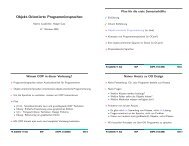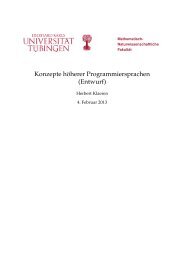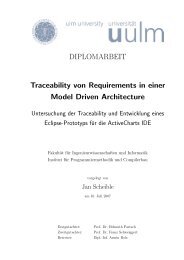Automated Model Quality Rating of Embedded Systems
Automated Model Quality Rating of Embedded Systems
Automated Model Quality Rating of Embedded Systems
You also want an ePaper? Increase the reach of your titles
YUMPU automatically turns print PDFs into web optimized ePapers that Google loves.
time. Figure 6 and Figure 7 show the trend <strong>of</strong> two metrics over three iterations <strong>of</strong><br />
the development process. In Figure 6, the relative trend is shown. If only the metric<br />
evaluations from section 3.1 are shown, however, it is impossible to determine to what<br />
extent a metric’s measured values depart from their permissible values. This is why<br />
Figure 7 shows the absolute trend <strong>of</strong> metrics. This representation clearly shows how<br />
the metrics’ measured values lie in relation to their limits and tolerance areas. It is thus<br />
possible to determine why Metric 2 has the value 0% in the second iteration. Moreover,<br />
this representation enables us to determine whether a measured value is moving towards<br />
its allowed limits even though it always remains 0% in the relative representation. Trend<br />
analysis therefore helps us to understand how quality rating came about over different<br />
points in time.<br />
100%<br />
50%<br />
0%<br />
100% 100%<br />
100%<br />
100%<br />
100% 100%<br />
100%<br />
Metric 1<br />
Metric 1<br />
50%<br />
Metric 2 Metric 2<br />
25% 25% 0% 0%<br />
0%<br />
1st iteration 1st 2nd iteration 2nd 3rd iteration 3rd iteration<br />
Fig. 6. Relative trend representation<br />
1,350<br />
1,350<br />
Maximum<br />
1,300<br />
Maximum<br />
1.300<br />
1,200 Metric 2<br />
1,200 Metric<br />
1,250<br />
2<br />
1,250<br />
1,150 1.150<br />
Minimum<br />
Minimum<br />
80 80<br />
Maximum<br />
60<br />
Maximum<br />
60<br />
Metric 1 Metric 1<br />
45<br />
52<br />
45<br />
52<br />
1st iteration1st iteration 2nd iteration 2nd iteration 3rd iteration 3rd iteration<br />
Fig. 7. Absolute trend representation<br />
Furthermore, relative trend analysis is not only restricted to metrics, but can also be<br />
applied to every element <strong>of</strong> the quality model. This makes it possible to get an overview<br />
<strong>of</strong> the progress <strong>of</strong> particular criteria or factors over time.<br />
5 Implementation and Further Evaluation<br />
The framework for rating model quality (cf. Figure 1) is currently implemented as a<br />
Java prototype, however a product called MQA Center (<strong>Model</strong> <strong>Quality</strong> Assessment<br />
Center) is planned for the future. The prototype is responsible for connecting external<br />
tools, executing metrics, and evaluating the quality model, as well as visualizing results.<br />
An example <strong>of</strong> an external tool with a parsed report is the guideline checker MXAM 5 .<br />
Alternatively, the external tools themselves can supply metrics that are then collected<br />
by the prototype. As soon as all measured values and information are available, model<br />
quality rating can be performed and visualized.<br />
The approach presented in this paper will be evaluated with the help <strong>of</strong> this prototype.<br />
The evaluation consists <strong>of</strong> three main components. The first is the comparison <strong>of</strong> models<br />
with one another. Combining this comparison with the ratings <strong>of</strong> developers as to the<br />
perceived quality <strong>of</strong> models means we can determine whether the basic direction <strong>of</strong> the<br />
model quality rating is appropriate. Then we can analyze the findings <strong>of</strong> model reviews.<br />
The nature <strong>of</strong> model review findings is that they very <strong>of</strong>ten only detect potential problems<br />
(issues and not necessarily errors). So we can test whether models with a lot <strong>of</strong> findings<br />
5 http://www.model-examiner.com








